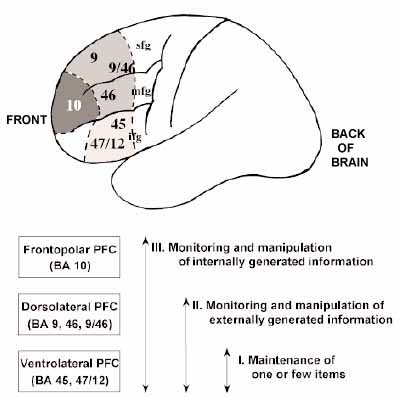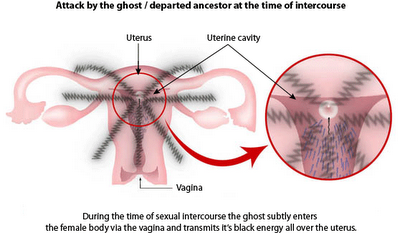Frontopolar Cortex Moves to the Back of the Brain
In case you missed this announcement, as I did, New Scientist has now declared that frontopolar cortex is in the back of the brain:
In addition, unlike in humans, the researchers also found spindle cells in the frontopolar cortex at the back of the brain...It seems that writers there also expect spindle neurons to be the next new thing.
Whales boast the brain cells that 'make us human'Hmm, but some researchers have argued that frontopolar cortex (aka Brodmann area 10) is one brain region that allows us to engage in the type of complex thought that distinguishes humans from other animals, described variously as subgoal processing (Braver & Bongiolatti, 2002), complex reasoning (Bunge et al., 2005), and manipulation of internally generated information:
15:00 27 November 2006
Andy Coghlan
. . .
They were touted as the brain cells that set humans and the other great apes apart from all other mammals. Now it has been discovered that some whales also have spindle neurons – specialised brain cells that are involved in processing emotions and helping us interact socially.
Spindle cells, named after their long, spindle-shaped bodies, are the cells that are credited with allowing us to feel love and to suffer emotionally...
The cells occur in parts of the human brain that are thought to be responsible for our social organisation, empathy, speech, intuition about the feelings of others, and rapid "gut" reactions.
. . .
As with humans, the spindle cells were found in whales in the anterior cingulate cortex and frontoinsular cortex – two brain regions vital for "visceral" reactions. Such reactions require fast but emotionally-sensitive judgments, such as deciding whether another animal is suffering pain, and the general feel of whether an experience is pleasant or unpleasant.
In addition, unlike in humans, the researchers also found spindle cells in the frontopolar cortex at the back of the brain, and they were sparsely dispersed elsewhere...
Christoff K, Gabrieli JDE. (2000). The frontopolar cortex and human cognition: evidence for a rostrocaudal hierarchical organization within the human prefrontal cortex. Psychobiology 28: 168-186.But Hof and Van Der Gucht (2006) carefully qualify the significance of their frontopolar finding in whales:
Numerous brain lesion and functional neuroimaging studies have suggested that the dorsolateral and frontopolar prefrontal regions are involved in complex cognitive processes subserving thought and memory. However, previously proposed functional subdivisions of prefrontal function have concentrated predominantly on posterior prefrontal cortex, including the dorsolateral, ventral, and medial regions. Far less consideration has been given to characterizing the psychological processes mediated by the frontopolar cortex. Here we review published neuroimaging studies of reasoning and episodic memory, two domains in which the frontopolar cortex has been frequently activated. The results suggest that dorsolateral prefrontal cortex is involved when externally generated information is being evaluated, whereas the frontopolar cortex becomes recruited when internally generated information needs to be evaluated. A hierarchical model of prefrontal function is proposed in which dorsolateral and frontopolar regions are serially recruited as a reasoning or memory task requires evaluation of internally generated information.
In addition, spindle cells in Megaptera occur in regions where they had not been seen in hominids such as the frontal polar cortex, although there is likely no functional or topographic homology between the frontopolar region in mysticetes and hominids.And they know that frontopolar cortex is in the front of the brain.
References
Braver TS, Bongiolatti SR. (2002). The role of frontopolar cortex in subgoal processing during working memory. Neuroimage 15: 523-536.
Bunge SA, Wendelken C, Badre D, Wagner AD. (2005). Analogical reasoning and prefrontal cortex: evidence for separable retrieval and integration mechanisms. Cereb Cortex 15: 239-249.
Hof PR, Van Der Gucht E. (2007). Structure of the cerebral cortex of the humpback whale, Megaptera novaeangliae (Cetacea, Mysticeti, Balaenopteridae). Anatom Rec Part A, 290:1-31.
Subscribe to Post Comments [Atom]































